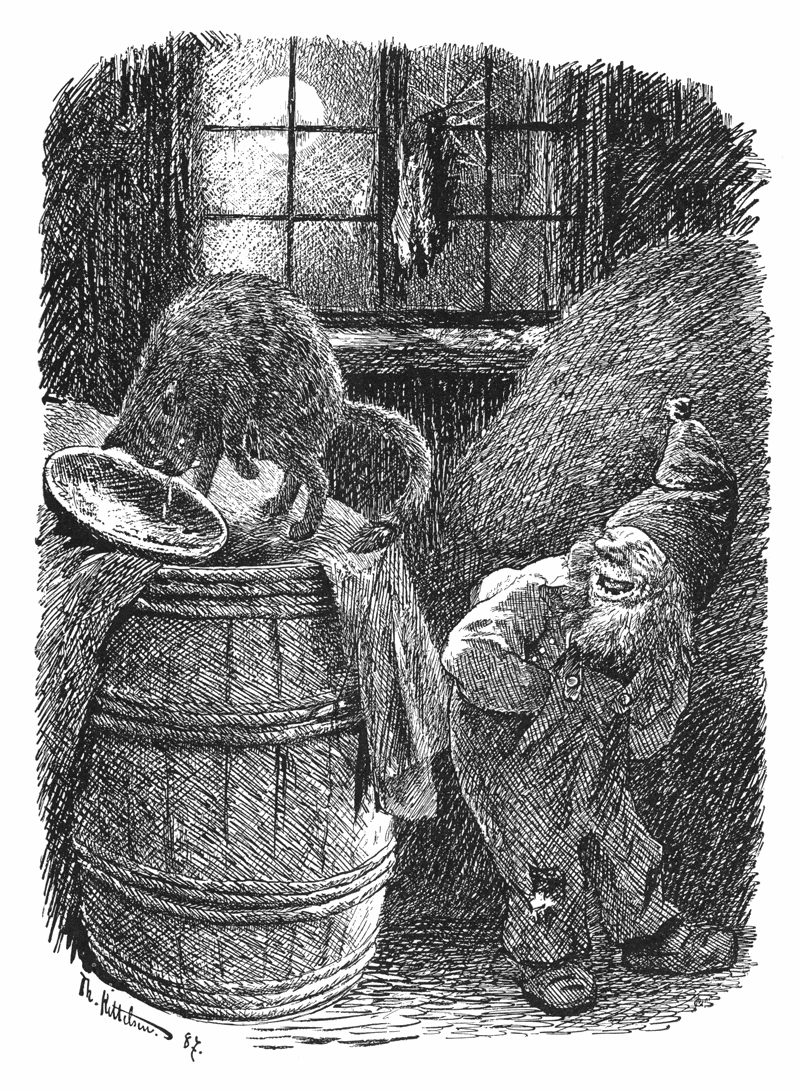In modern day Scandinavia, nissen or tomten is first
and foremost associated with the
Christmas holidays, and often perceived as a Scandinavian version of Santa
Claus. This association is however rather misleading - it is also important not to mistake him with somewhat similar creatures, like elves or goblins. Nissen stands out on his own, and represent a quite different set of values.
In the old Nordic folklore, he existed as a figure
who lived very close to people in their everyday existence. He was primarily
imagined as an elderly man, not much taller than a child, who bore clear signs
of high age, his face yellow
as parchment, wrinkled like an old tree root. He often had a full
beard and dressed in the everyday clothing of a farmer, in grey wadmal clothes,
breeches, a long jersey and a red woolen
cap. He was quite hairy, all
over the body, as well as unreasonably strong for such a tiny creature.
 |
| Theodor Kittelsen, "The Nisse" (1887) |
Unlike dwarves and the hulder people, who inhabited
the hills and forests, nissen
had his abode in
houses and barns, and served as a guardian, as well as a
helper. He was essentially good-natured, and loved conducting
practical jokes. It was however, important to be on good terms with him, for he
could create a lot of turmoil if he was
neglected.
The priest and historian
Andreas Faye has
written:
"Nissen is generally an honorable being. If treated with kindness and respect, he is very willing to be of service. He helps the milkmaid to take care of the animals, and helps the cook to scour, carry water and do other heavy work; she must nevertheless make sure she does not upset him, or forget to supply him with good food and drink – especially around Christmas."
Hence, at Christmas Eve, nissen
was presented with the very best of the local cuisine; normally this included a decent portion of Christmas
porridge, lefse (a traditional soft, Norwegian flatbread) and beer. If nissen was not satisfied, he
would not hesitate to revenge
himself by making life unpleasant for
the people around him. Well-known is the story about the girl who was so hungry
that she ate the porridge herself, instead of giving it to nissen. He later on retaliated by dancing with the
girl, till she died.
Other stories may however be
of a more humorous form. A legend from Østfold in southeastern Norway tells for
instance about a milkmaid who got help
from nissen to look after the cows. In addition to rightfully supply him
with milk and treats, the
maid one day also decided to sow him
some new clothes. This gesture however, turned out to backfire on the poor girl. One evening, nissen came to the house,
wearing his new ensemble. Rather baffled, the maid received a resignation from the little geezer, who proclaimed he was too pretty now to struggle and strive in the barn!
The modern day Nisse
 |
| The nisse is frequently depicted with a bowl of Christmas porridge - in this image portrayed by the Norwegian illustrator Svein Solem. |
Stories and Christmas
cards from the late 1800s have helped to spread
the image of nissen,
and preserved him as an important part of Scandinavian culture. Although he has adapted some features from the commercial, American Santa Claus, the old-fashioned fjøsnisse
still remain as perhaps one of the foremost symbols of Norwegian Christmas.
Even nowadays many still put out a bowl of porridge for him on Christmas
Eve – a survey conducted in 2009 showed that 9% of
all Norwegians carry on this 1000 year old tradition.
“På låven sitter nissen” (The nisse in the barn) is a Christmas
song with lyrics by Margrethe Munthe. It
was first printed in 1911, and
still remains as one of the most well-known and beloved Christmas carols,
especially among the youngest. It is truly a cheerful and sweet little tune,
and tells about nissens fight to keep his
Christmas porridge - a bunch of mice
are namely trying to steal it. But nissen is an old grump and refuses to share. The
first verse goes something like this (a presentment of the melody follows below):
The nisse in the barn has got his Christmas treat, so good and sweet, so good and sweet!
He nods his head and smiles, oh so happily, cause Christmas porridge, he just loves to eat!Eventuelly, nissen threatens to retrieve the cat if the mice do not disappear. As by a stroke of magic the conflict is terminated, and the little rodents flee the scene.
And around him stand the rats that think he’s sharing, and they’re staring, and they’re staring.
They are also very fond of Christmas porridge, and they’re dancing, dancing in a ring!
Sources:
- Faye, Andreas. Norske Folke-Sagn. Norsk Folkeminnelags Forlag. Tredje Oplag. Oslo 1948.
- Hodne, Ørnulf. Norsk folketro. J.W. Cappelens Forlag. 1999.
- Hodne, Ørnulf. Vetter og skrømt i norsk folketro. J.W. Cappelens Forlag. 1995.
- Tidens Krav (18.12.2009). "Nissen får fortsatt grøt". URL: http://www.tk.no/jul/article4767107.ece

I came across this blog post as I was doing a bit of reading about nisse. I am Canadian but my maternal grandparents were from Norway. I appreciate learning as much as I can about Norwegian culture and traditions. I enjoyed this post.
ReplyDeleteIn appreciation
Connie Sanche
interesting, thanks
ReplyDeleteThank you. I've seen so many knomes for sale this cmas like the tradition had been revived. I'm also third generation Norwegian and want to learn about this folklore.
ReplyDeleteLove this! I didn’t know about this tradition. Thank you!
ReplyDeletecool
ReplyDelete